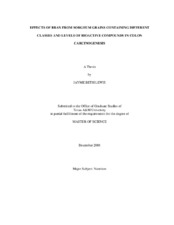| dc.description.abstract | In order to test the dietary effects of bioactive compounds present in whole
grains, we decided to observe the effect of varying types of sorghum bran on colon
cancer promotion. We used 40 rats consuming diets containing 6% fiber from either
cellulose or bran from white (contains phenolic acids), brown (contains tannins), or
black (contains anthocyanins) sorghum (n=10). Diets were fed for 10 wk, during which
two azoxymethane (AOM) injections (15 mg/kg BW) were administered in wk 3 and 4.
We observed that the total number of aberrant crypts (AC) and high multiplicity
aberrant crypt foci (HMACF) were lower in rats consuming black (p < 0.04) and brown
(p < 0.006) sorghum diets when compared to the cellulose diet, and that these decreases
were an inverse function of diet antioxidant activity (ABTS). These observations led us
to evaluate the effect of these diets on endogenous enzymatic activities (superoxide
dismutase, SOD; catalase, CAT; and glutathione peroxidase, GPx), redox status as
measured by reduced and oxidized glutathione, and cell cycle processes, proliferation
and apoptosis, in the rat colon. Total SOD activity was higher (p < 0.04) in rats
consuming black sorghum when compared to all other diets. A similar, but not significant, trend occurred in mitochondrial SOD. The white sorghum diet had enhanced
(p < 0.02) CAT activity compared to the cellulose diet, but the black and brown sorghum
diets were intermediate. Finally, all sorghum diets suppressed GPx activity relative to
cellulose (p < 0.04). However, no changes were seen in levels of reduced and oxidized
glutathione or the ratio of the two.
The black sorghum fed rats had a lower proliferative index (p < 0.01) and zone (p
< 0.04) compared to cellulose; brown and white sorghum rats were intermediate.
Apoptotic index was highest in brown sorghum rats compared to cellulose (p < 0.03),
while other sorghum diets were intermediate. These data suggest that the suppression of
AC and HMACF formation in rats consuming sorghum bran may have resulted through
the differential actions of the sorghum brans on endogenous antioxidant enzymes, which
may affect colonocyte proliferation and apoptosis. | en |


